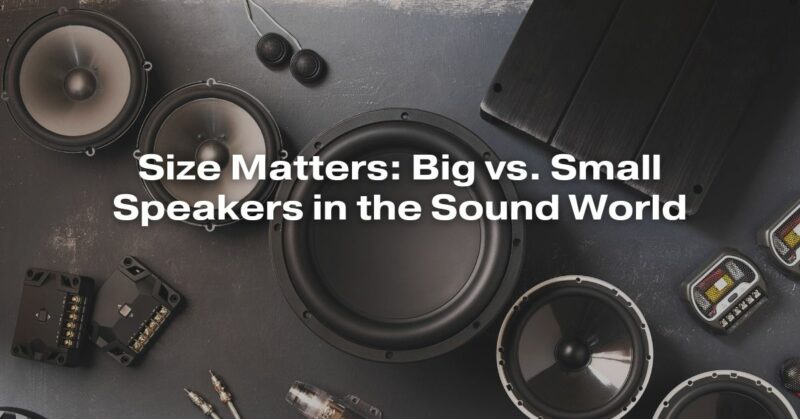When it comes to audio quality and the world of sound reproduction, the debate over the significance of speaker size has been ongoing for decades. Audiophiles, sound engineers, and music enthusiasts have all weighed in on whether bigger speakers are truly better or if smaller ones can hold their own. In this comprehensive article, we’ll explore the advantages and disadvantages of big and small speakers, and how they impact the overall listening experience.
The Basics: Understanding Speaker Size
Before delving into the nuances of big and small speakers, it’s important to understand what speaker size actually means in the context of audio equipment. Speaker size typically refers to the diameter of the speaker’s driver, which is the component responsible for producing sound waves. The size is measured in inches or millimeters and is commonly referred to as the speaker’s “woofer” size. Larger speakers have bigger woofers, while smaller speakers have smaller ones.
Big Speakers: The Advantages
- Deep Bass: One of the most significant advantages of big speakers is their ability to reproduce deep bass frequencies accurately. The larger surface area of the woofer can move more air, resulting in a fuller and more powerful low-end response. This makes big speakers ideal for genres like hip-hop, EDM, and action movie soundtracks where thumping bass is crucial.
- High Volume: Big speakers are capable of producing higher sound volumes without distortion. This is particularly advantageous for large rooms or outdoor events where sound dispersion is essential.
- Improved Soundstage: Big speakers often excel at creating a more immersive soundstage, providing a sense of depth and dimensionality to the audio. This can enhance the listening experience for classical music, jazz, and orchestral performances.
- Durability: Due to their larger build, big speakers tend to be more robust and durable, making them suitable for professional use in studios or live performances.
Big Speakers: The Disadvantages
- Size and Portability: The most obvious drawback of big speakers is their size. They can be bulky and heavy, making them less suitable for smaller living spaces or on-the-go use.
- Cost: High-quality big speakers can be expensive. The larger drivers, better materials, and advanced engineering required for big speakers often come with a higher price tag.
- Power Requirements: Big speakers often demand more power to reach their full potential, which may necessitate a more powerful amplifier or receiver.
- Limited Placement Options: Due to their size and shape, big speakers may have limited placement options within a room, potentially compromising the aesthetics of the space.
Small Speakers: The Advantages
- Compact and Portable: Small speakers are incredibly convenient due to their compact size and portability. They’re ideal for small apartments, home offices, or for taking music on the go.
- Affordability: Generally, small speakers are more budget-friendly than their larger counterparts. This makes them accessible to a wider range of consumers.
- Versatility: Small speakers can be integrated into various setups, including home theaters, desktop audio systems, and even as part of multi-room audio configurations.
- Aesthetics: Small speakers are less obtrusive and can easily blend into the decor of a room. Many manufacturers offer sleek and stylish designs.
Small Speakers: The Disadvantages
- Limited Bass Response: Due to their smaller size, small speakers often struggle to reproduce deep bass frequencies accurately. This can lead to a less satisfying audio experience, especially for bass-heavy music genres.
- Lower Volume Levels: Small speakers may not be able to reach the same high volume levels as big speakers without distortion.
- Soundstage: Achieving a wide and immersive soundstage can be challenging with small speakers, which can limit their suitability for certain genres and applications.
- Durability: Smaller speakers may not be as rugged as their larger counterparts, which can affect their lifespan and suitability for professional use.
The Middle Ground: Mid-Size Speakers
For many, the debate between big and small speakers can be resolved by opting for mid-size speakers, which offer a compromise between the two. Mid-size speakers typically provide better bass response and volume compared to small speakers while remaining more compact and affordable than large speakers. This makes them a popular choice for a wide range of applications, from home audio setups to smaller event venues.
Conclusion
In the world of audio, the debate over big vs. small speakers ultimately boils down to personal preferences and specific use cases. There is no one-size-fits-all answer, as each type of speaker has its own set of advantages and disadvantages. Audiophiles and music enthusiasts should consider their listening environment, musical preferences, budget, and space constraints when choosing between big and small speakers. Additionally, the integration of subwoofers and other audio equipment can help mitigate some of the limitations associated with speaker size, allowing individuals to tailor their audio systems to their unique needs and preferences. Ultimately, whether you go big or small, the most important factor is that you enjoy the music you’re listening to, and that it suits your individual lifestyle and preferences in the world of sound.

